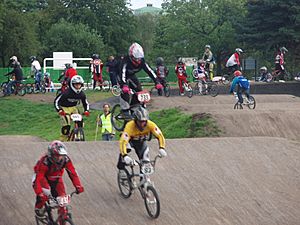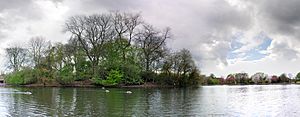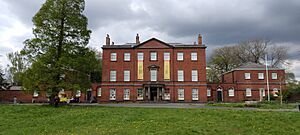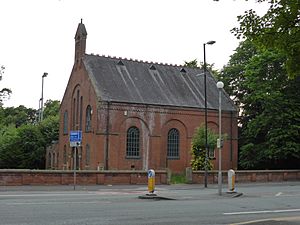Platt Fields Park facts for kids
Quick facts for kids Platt Fields Park |
|
|---|---|
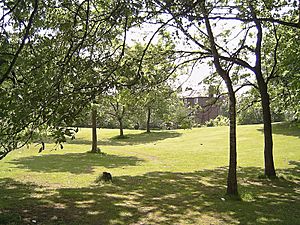 |
|
| Type | Municipal park |
| Location | Fallowfield, Manchester, England |
| Area | 70 hectares (170 acres) |
| Created | 1908 |
| Operated by | Manchester City Council |
Platt Fields Park is a big public park in Fallowfield, Manchester, England. It's a great place to visit and is also home to Platt Hall. The park is located in the south of Manchester, with Wilmslow Road along its eastern side. Its north-eastern corner is near the start of the famous Curry Mile.
Contents
Exploring Platt Fields Park
The main part of the park is a large pond. People used to go boating and fishing here. The pond has a special island in the middle, which is a safe place for wildlife. There's also a visitors' centre and a boathouse by the pond. You can also find parts of Gore Brook and the ancient Nico Ditch in the park.
Gardens and Green Spaces
Platt Fields Park has many different kinds of gardens. There are community orchard gardens with ferns, roses, and heather. You can also find an educational garden and an environmental area. The park has Elizabeth II Jubilee gardens and an Eco Arts garden near the boating pond.
In the south-east corner, there's a special Shakespearean garden. It's designed to have only plants that are mentioned in Shakespeare's plays. This area, called Ashfield, also has an arch from Manchester Cathedral. It was given to the city by Edward Donner.
Fountains and Play Areas
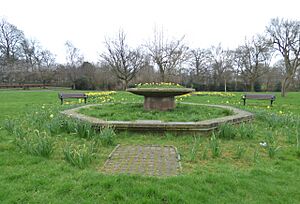
Near Platt Hall, in the north-eastern part of the park, you'll see the Queen Elizabeth Coronation fountain. This fountain was moved to Platt Fields in 2002. It was first placed in Piccadilly Gardens in Manchester City Centre in 1953. This was to celebrate the Coronation of Queen Elizabeth II. You can even see the fountain in a painting from 1954 by L. S. Lowry called Piccadilly Gardens.
The park has a labyrinth and a picnic area. There's also a veterans' pavilion and two children's playgrounds. One playground is for younger kids up to age 5, and the other is for children up to age 9. Both are close to the Lakeside Centre.
Sports and Activities
Platt Fields Park offers many sports facilities. There are two bowling greens and courts for basketball, five-a-side football, roller hockey, and tennis. You can also find a mini soccer pitch, cycle paths, and a skate park. A new BMX track was finished at the south end of the park in the summer of 2008.
The old boathouse is now home to Platt Fields Bike Hub. This is a community project that helps with bicycle repairs and bike hire. They also run other cycling activities.
The park has three special show fields. These fields are set up to host big and small events. Past events include the Manchester Mela and Eid Festival. The park also holds annual fireworks and bonfire displays. Until 2003, it hosted the Manchester Flower Show. The park has a car park with disabled parking and toilets. There is also a park office.
History of Platt Fields Park
The area was first mentioned around 1150. At that time, the "lands of Platt" were given to the Knights of St John. The Platt family then owned the land for 400 years, starting in 1225. In 1625, the Worsley family took over the estate. It was a country park called the Platt Hall Estate. William Emes designed the park's landscape in 1768. The Worsley family owned it until 1907.
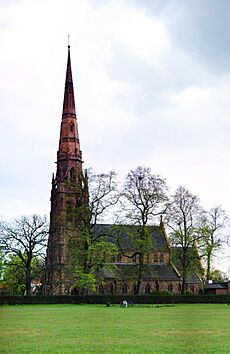
By the early 1900s, the estate was surrounded by more and more houses. Because of this, the Worsley family decided to sell it in 1907. People worried the park would be sold for new buildings. Some even suggested tearing down Platt Hall for bricks. William Royle helped gather support for the city to buy the estate. This led to the Lord Mayor of Manchester holding a meeting. It was decided to buy the estate for a public park. The city bought it in 1908 for £59,975.
During a time of high unemployment in the winter of 1908 and 1909, over 700 men helped rebuild the park. They planted trees and shrubs, moved Gore Brook, and created a lake and island. The park, named Platt Fields Park, officially opened on May 7, 1910. Sir Charles Behrens, the Lord Mayor of Manchester, opened it.
The main lake had a large boathouse. It held many rowing boats and a motor launch called the Archie Littlemore. This boat gave rides around the island in the summer. Later, a paddling pool and two model boating lakes were built. One of these lakes was home to the Platt Fields Model Yacht Club. There was also a track for large model railway vehicles, where people could ride on the trains.
The park also had an open-air swimming pool called the Platt Fields Lido. It was 25 yards long. Later, the Lido closed and became a "Pets Corner" with small animals and birds. Today, all traces of the Lido are gone, and the area is now landscaped.
The park was used for many sports, including tennis, football, bowling, and cricket. More work was done between 1919 and 1925. During this time, the park and playing fields were made level. Bowling greens and tennis courts were built. An amphitheatre with a stage was also built into the ground. A Speakers' Corner was once located near the Holy Trinity Platt Church.
The park had a tennis pavilion built in 1926. It was taken down in January 2006. The park also used to have a Pets Corner and Animal Park, a children's playground, a café, and rose gardens.
In 1980, two brothers, Stuart and Paul Yearsley, wanted to bring model boating back to Platt Fields. They got permission to hold a special event. This led to the creation of The Platt Fields (silent) Model Boat Club. The club, now called South Manchester Model Boat Club, still meets at the lake on Sunday mornings. It is a popular attraction in the park.
Friends of Platt Fields Park
The Friends of Platt Fields Park is a group of volunteers. They are a registered charity. Their goal is to help maintain and promote Platt Fields Park for everyone to enjoy.
Platt Hall
Platt Hall was the home of the Worsley family for 300 years. The current hall is a beautiful Georgian building. It was built in 1746 by John and Deborah Carill-Worsley. It cost £10,000 to build. The hall replaced an older timber building. That building was once the home of Charles Worsley, who was an important leader during the time of Oliver Cromwell.
Former Gallery of Costume
From 1947 to 2021, Platt Hall was home to the Gallery of Costume. This museum displayed clothes from the 17th century up to modern times. The collection belongs to the Manchester Art Gallery. In 2021, the collection was moved from Platt Hall. It is now stored and will be moved to a new space at the main gallery on Mosley Street. The future plans for Platt Hall are still being decided.
Platt Chapel
Platt Chapel is on Wilmslow Road. The building you see today was rebuilt in 1790 and changed again in 1874–75. It was originally a family chapel for the Worsleys of Platt Hall, built in 1699. It was built for Henry Finch. The church group started as Independents (Congregationalists) and later became Unitarian in the early 1800s.
The chapel stopped being used for worship in 1970. Since 1977, it has been used by different local groups. The graveyard, which used to be larger, is now surrounded by Platt Fields Park.
See also
 In Spanish: Platt Fields Park para niños
In Spanish: Platt Fields Park para niños
- Grade II* listed buildings in Greater Manchester
- Listed buildings in Manchester-M14
- Appleby Lodge, a building opposite Platt Fields on Wilmslow Road


